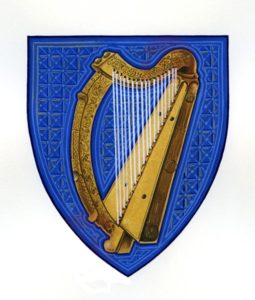 The harp itself is a symbol for an ancient, pure Ireland, an Ireland before the arrival of the Normans in the twelfth century. The symbolic use of the harp appears in many different mediums, such as poetry. In 1807, Thomas Moore wrote The Harp that once through Tara’s Halls, describing the ancient castle of the High Kings of Ireland and how the structure is now in ruin. He further describes the forgotten majesty of the castle, writing of the chiefs and ladies that once walked through the halls and of the harp music that once echoed off the stonewalls. He writes, “The harp that once through Tara’s halls/ The soul of music shed,/ Now hangs as mute on Tara’s walls/ As if the soul were fled”[1], meaning that since the harp ceased to play, the true spirit of Ireland ceases to manifest.
The harp itself is a symbol for an ancient, pure Ireland, an Ireland before the arrival of the Normans in the twelfth century. The symbolic use of the harp appears in many different mediums, such as poetry. In 1807, Thomas Moore wrote The Harp that once through Tara’s Halls, describing the ancient castle of the High Kings of Ireland and how the structure is now in ruin. He further describes the forgotten majesty of the castle, writing of the chiefs and ladies that once walked through the halls and of the harp music that once echoed off the stonewalls. He writes, “The harp that once through Tara’s halls/ The soul of music shed,/ Now hangs as mute on Tara’s walls/ As if the soul were fled”[1], meaning that since the harp ceased to play, the true spirit of Ireland ceases to manifest.
In 1815, he wrote Dear Harp of my Country, a poem in which he essentially is writing directly to the harp of Ireland. He writes, “Dear Harp of my Country! In darkness I found thee,/ The cold chain of silence had hung o’er thee long”[2], meaning that the harp of Ireland has long been silent due to the oppression of the British in the Emerald Isle. This oppression, according to Moore, is the reason that the true Irish spirit ceases to be found in a pure form, and thus, the only way this spirit can manifest once more would be to expel the British from Ireland.
James Clarence Mangan wrote To My Native Land in 1832, in which he writes, “The harp remaineth where it fell, / with mouldering frame and broken chord”[3]. By describing the harp as having a deformed frame and a broken chord, he is implying that the harp itself will forever be irreparable, thus meaning that Ireland will never again know the purity that once existed.
Click Here to Return to Stamps
[1] Stephen Regan, Irish Writing: An Anthology of Irish Writing in English 1789-1939 (Oxford: Oxford University Press, 2004), 133.
[2] Ibid., 132.
[3] Ibid., 141.
